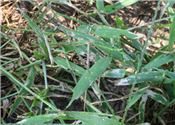|
Forage Producers Fight Weather, Pests For Crop
RAYMOND, MISS.
Mississippi forage producers can grow a bountiful crop, but they are fighting wet weather and pests to harvest all of it.
Rocky Lemus, forage and grazing specialist with the Mississippi State University Extension Service and researcher with the Mississippi Agricultural and Forestry Experiment Station, said hay harvest is about 5 percent behind where it was this time last year.
“The wet weather we’ve had has kept us out of the field,” he said. “So, we’re a little behind.”
Dr. Brett Rushing, MSU Extension forage specialist discusses the condition of forage crops in Mississippi on July 26, 2019.
Lemus said Mississippi grew about 10,000 fewer acres of hay than in 2018, putting the state’s production at about 640,000 acres for 2019. According to the U.S. Department of Agriculture Crop Progress and Condition Report released on July 28, the first cutting of cool-season hay is 99 percent complete. Pasture ground is rated 50 percent good, 31 percent fair and 13 percent excellent.
Producers in central and south Mississippi have plenty of hay and pasture grass this year.
“Growing it isn’t a problem; it’s getting the hay out of the field. We need some dry days so that we can cut, rake and bale it,” said Brett Rushing, Extension forage specialist and Experiment Station researcher.
Moving hay out of the field becomes even more important as July winds down. Pests can invade forages, heavily damaging or wiping out crops intended to feed livestock through the winter.
Armyworms are the most devastating pest Mississippi producers encounter in forages, and their numbers begin to ramp up at the beginning of August. Left unchecked, they can destroy hay and pasture fields in just a few days because of their quick growth cycle. Armyworms can complete their life cycle in 60 days during the spring and fall, about 30 days during the summer and 90 days during the winter, depending on how cold it gets, Lemus said.
“I was scouting my summer annual trials and the armyworms have arrived along with sugar cane aphids,” said Lemus, referring to forage test plots planted at the MSU R.R. Foil Plant Science Research Center, also called South Farm. “Producers should be checking their pastures and hay fields. Armyworms often invade grasses in wet areas and may become most abundant after flooding has occurred. Areas with high rainfall with a dense forage canopy can become areas for higher infestations.”
Sugar cane aphids can overcome crops quickly. These nonnative pests require intensive scouting and multiple insecticide applications for management. Bermudagrass stem maggots, an invasive species recently established in the state, are plaguing hay fields, as well. This pest interferes with stem growth and is particularly devastating to mid- and late-season harvests.
“Bermudagrass stem maggots are problematic this year, and they are here to stay,” said Rushing, who is based at the Coastal Plain Branch Experiment Station in Newton. “The good news is diligent scouting and using best management practices can keep producers from losing crops. We’ve learned better ways to manage them. We now have better products, and we’ve learned better timing and rates of insecticide application. But the weather has to cooperate so that we can get in the field and make the applications at the right time.”
Rushing said he expects a good year for fall forages if rains come at the right times.
“We should have a good fall as long as the moisture trends continue,” he said. “If that happens, we’ll be in good shape.” ∆

When scouting for armyworms, producers look for damage, such as this seen on signal grass at the Mississippi
State University Coastal Plain Experiment Station in Newton on July 26, 2019.
The discoloration is called frosting and is usually the first sign of armyworm presence.
Photo by MSU Extension Service/Susan Collins-Smith
|
|